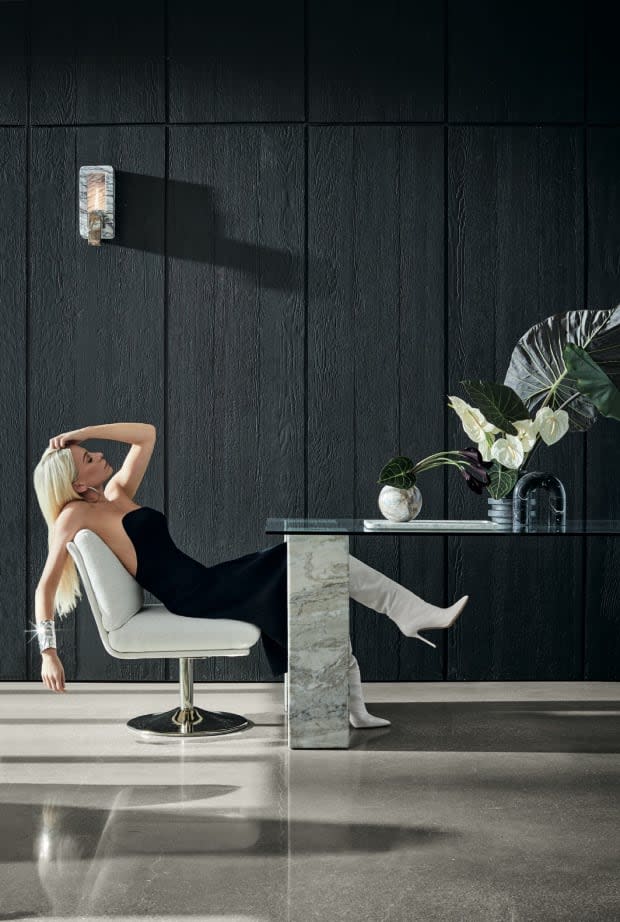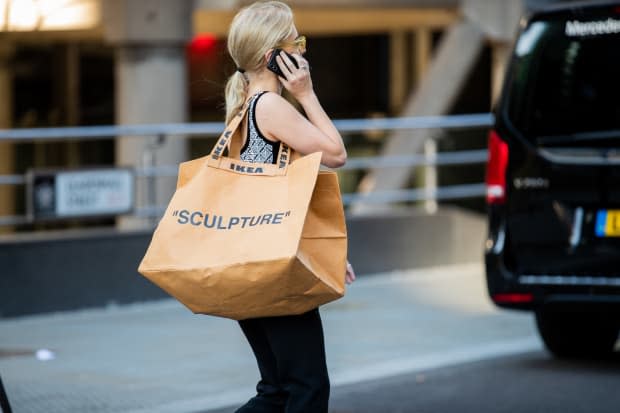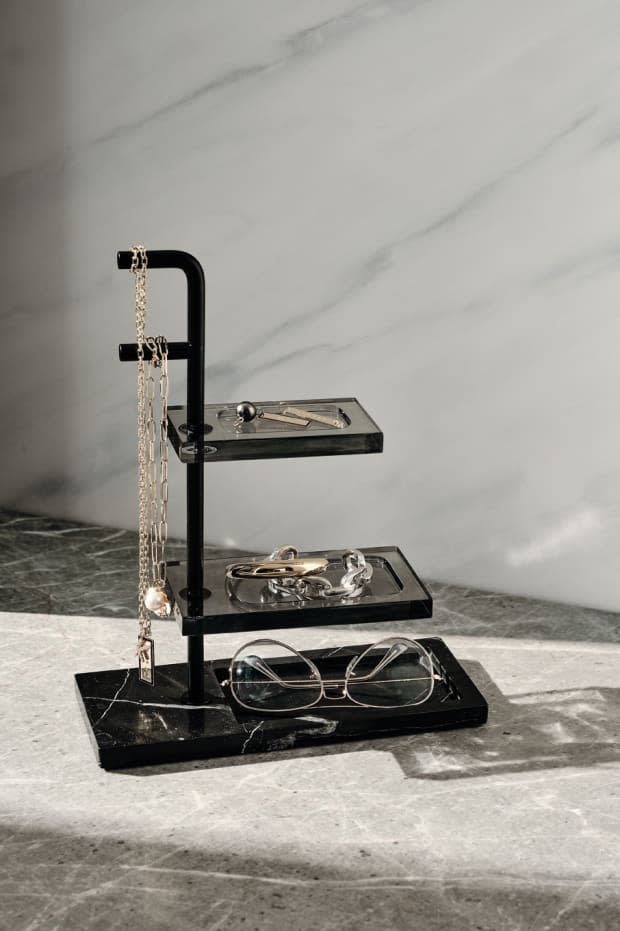Fashion and Furniture Companies Are Getting Cozier and Cozier
Jennifer Fisher just unveiled a 108-piece collection for CB2 — the latest example of a fashion designer dipping their toes into home.

Stylist-turned-entrepreneur Jennifer Fisher is best known for her elegant fine jewelry staples, from charm necklaces to thick hoops that have been worn by just about every celebrity and Instagirl we can think of. Her namesake line was born out of a passion project and designing jewelry is still something she loves doing. (And given that her company is currently in growth mode, with plans to open a Beverly Hills flagship, she's good at it.) But it turns out she's also good at designing furniture.
Despite never having thought about getting into the home category (unless you count her unexpected foray into salt), she couldn't turn down an offer from Ryan Turf, the president of CB2, to create her dream home and furniture collection, which ended up encompassing over 100 products. From spill-proof martini glasses and a chic, clear dog door, to a dining table that turns into an oddly elegant ping-pong table and a surprisingly affordable all-marble coffee table, every piece is functional, thoughtfully designed, understated and aesthetically pleasing in the way Fisher's jewelry is, without looking too much like a jewelry designer made it.
"When people think about me doing a collaboration, because I'm a jewelry designer, they're automatically like, 'Oh, this is gonna be like chains and gold.' And I was like, that's the last thing I want to put in my house," Fisher tells Fashionista.
She is the latest in a string of fashion designers and labels to extend their brands into the home — and, in particular, furniture — category within the past couple of years. There was Virgil Abloh's widely hyped collaborations with Ikea and Vitra, Jason Wu's line of sofas with Interior Define, Clare V and Peter Som's print designs for sustainably produced furniture e-commerce site The Inside and stylist-turned designers Emilly Current and Merrit Elliott's longstanding (and successful) partnership with Pottery Barn. Scott Sternberg's cult-beloved, digitally native Entireworld worked with Design Within Reach for the brand's first-ever physical retail presence last year; and CB2 recently wrapped up a furniture collaboration with GQ.

Brand extensions and headline-grabbing collaborations are of course nothing new in the fashion industry. The dream of creating a "lifestyle brand" à la Ralph Lauren in the '90s was once every designer's end goal. And collabs and licensing deals are now such a common marketing tactic that we rarely consider them newsworthy. But there seems to be something different afoot in the home category, with the lines between home and fashion weakening in a new way.
Countless e-commerce sites that started with fashion have expanded into or deepened their offerings within home in recent years — The RealReal, Moda Operandi, Need Supply, The Dreslyn and Matchesfashion.com, to name a few. Luxury fashion brands like Gucci and Louis Vuitton, meanwhile, have also entered the category with more fervor than ever before. We've also seen many top fashion influencers and bloggers pivot into home decor, posting vibe-y shots of their vintage and/or gifted furniture-filled homes as often as they do their outfits.
"On one hand, social media allows us into each others homes, and the images we put out as a means of self expression include both our clothing and our environment," posits Sternberg. "On the other, the heyday of Ralph Lauren home or Habitat Catalog, which I see as making more holistic, expansive connections between fashion and home seem less important than, like, DTC brands who sell one perfect whatever for your home instead of a whole lifestyle or dream."

In other words, fashion and home are coming together in different ways than they did in the past, and social media — and the voyeurism it perpetuates — has a lot to do with it. Just as influencers use it to give their followers a look into where and how they live, Instagram is also impacting the way brands design experiences, from runway shows and events to retail, motivating them to build out a full, on-brand environment that may include textiles and furniture, as opposed to one that merely highlights the clothing.
"Instagram has become a primary window to how we experience products and decide to shop," explains Gemma Riberti, head of interiors for trend forecasting service WGSN. "Therefore a curated presentation of a brand with a lifestyle lens — showcasing from what to wear to the spaces in which to live — immediately has an aspirational appeal."
Related Articles
How Jennifer Fisher Plans to Become the Paul Newman of Fashion
Why Fashion Bloggers Are Evolving Into Home Decor Influencers
Why Ikea's Creative Leader Thinks the Company's Recent Chicness Will 'Open Doors'
"With the advent of digital image sharing, the best images will inspire everyone from interiors, to fashion, to food styling," says Christiane Lemieux, founder of The Inside. "Great design is no longer relegated to its own discipline, but instead influences all."
And for many designers who might already have a love or obsession for interiors personally— that aligns with the point of view of their fashion projects — expanding into that category comes that much more naturally.
"People have asked me for years when I was going to do something like this," says Fisher. "I think it's a natural extension if you do do something in one category and it's working, your customer base and your brand fan base naturally wants to see more from you"
For Current and Elliott, creating furniture and other home goods felt like an extension of the way they worked as stylists; they liken styling a room to styling a fashion shoot. "As we were given the opportunity [to design home], the answer was yes because we'd already thought about it," says Current. "We were collecting [home] things in the same way we were collecting vintage clothes." Current and Elliott also carry a number of home goods in the West Hollywood store for their brand The Great, and even hosted a pop-up for influencer-beloved DTC table settings company Year and Day.
View the original article to see embedded media.
Of the alignment between his brand and DWR, Sternberg explains: "Entireworld was inspired by modernist designers like Charles and Ray Eames as much as it was by any particular fashion design reference. So, the conceptual framework for the project was immediately evident — to create environments that explored the relationship between our product and the ones they carry." And while Entireworld hasn't launched its own home goods yet, Sternberg — who calls himself a "closet interior designer" — hopes to eventually.
This new era of fashion brands exploring furniture may also represent a greater shift in how consumers are spending and the types of connections they have with their favorite brands. With the global home furnishings market growing faster than fashion, according to WGSN, many consumers might consider a furniture purchase to be more desirable or even more reasonable than a fashion one.
"While a garment might be an investment unaffordable for many, the perception shifts when it relates to the home," notes Riberti. "Fashion is starting to see design and interiors as a new field in which to expand their influence and build new connections with consumers, especially in a time where there is a lot of backlash on the sustainability of fashion collections. Homewares are being perceived as a safer, more long-term and overall more meaningful category to invest in."
Fisher echoes this sentiment, explaining that her CB2 line "allows people to have a piece of the brand that might not be necessarily [able to afford] the jewelry." CB2 isn't exactly cheap, but to many, a quality $1,600 table makes more sense than a quality $1,600 pair of earrings. By partnering with a mass retailer, there's also, of course, the opportunity to expose your brand to a new audience, which is true of many types of collaborations and brand extensions.
In fact, one of the markers of success in these fashion-home collaborations could be the product's ability to stand on its own as something shoppers will gravitate towards regardless of whether or not they're familiar with the fashion designer involved. That's appeared to be the reason for the longevity of Emily & Merritt's Potter Barn collaboration, which began nearly 10 years ago.
View the original article to see embedded media.
"When we started this project, we came at it from a product place, we're product people," explains Elliott. "Whether it says our name on the packaging or not, we knew that the selling point was: It had to be good product that felt different. Collaborations can flood the market and now we have access to everything and we knew that it would be a sustainable partnership if it wasn't just about the PR angle."
On the other hand, if you look at a brand like Alessandro Michele's Gucci that has managed to create an immersive and unmistakable aesthetic that immediately inspires an emotional connection, it's easy to see the opportunity in offering products from every aspect of that world. And while not every brand has Gucci's brand awareness or resources to whip up all those products, smaller brands still have the opportunity to inspire emotional connections and perhaps build off of them through collaborations instead. It's about the whole picture coming together as fashion fans increasingly see their homes as an extension of their personal style.
"Seeing interiors surrounded by clothing, it bridges the gap," says Current, "like, all of the sudden it's what you're eating out of, it's what you're wearing, it's what you're hanging your hat on, it's what your hat looks like. It's all those things together."
Never miss the latest fashion industry news. Sign up for the Fashionista daily newsletter.
